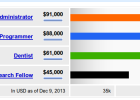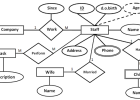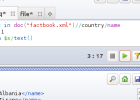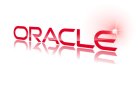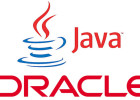Oracle : Type/Object Creation, Inheritance and Method Implementation with Examples
In this tutorial, we will try to go through a problem for modelling a system for storing polygon objects which have their own methods for computing the area or perimeter.
The objects that we should have are :
- Point ( x , y )
- Side ( Point, Point )
- Polygon ( Sides)

Creating Objects in Oracle
1 Create a new type for point
create or replace type point as object( x number, y number )
2 Create a new type for side
create or replace type side as object(
a point,
b point,
member function get_length return integer
);
[info] Note that the side has a member method named get_length which should return an integer[/info]
Implementation of Methods
3 Need to add the implementation for get_length method for the side object using the syntax below. The self keyword, is the same as in Java which refers to the object itself.
self.a.x refers to the x value for the point a
create or replace type body side as
member function get_length return integer is
begin
return sqrt( ((self.a.x-self.b.x)*(self.a.x-self.b.x)) + ((self.a.y-self.b.y)*(self.a.y-self.b.y)) );
end;
end;
Nested Tables
4 Because the polygon contains a set of sides, we need to create a nested table as new type for storing the set of sides.
[info] Consider Nested Tables in Oracle as a Vector in Java for storing Objects.[/info]
create or replace type side_ns as table of side;
Creating an object : shape
5 The shape object should have a name as well as a set of sides. Two methods should be defined within the creation of the type. The syntax is shown below:
create or replace type shape_tp as object( name varchar2(20), sns side_ns, member function get_perimeter return integer, member function get_area return integer ) NOT FINAL;
6 The implementation of the two methods is shown below. Get_area returns 0 for now. There is a loop within the code.
[info] myres NUMBER; is a definition for a local variable[/info]
[info]The special method :dbms_output.put_line is the same as System.out.println in Java for displaying messages on the console.[/info]
create or replace type body shape_tp as
member function get_perimeter return integer is
myres NUMBER;
begin
myres := 0;
for ind IN 1..sns.count LOOP
dbms_output.put_line('Side has length '|| sns(ind).get_length());
myres :=myres + sns(ind).get_length();
END LOOP;
return myres;
end;
member function get_area return integer is
begin
return 0;
end;
end;
Creating a table with nested table
7 We need to create a database table to store the shape objects.
[success]Because the shape object has a nested table as its attribute. The new table needs to be made aware by adding the NESTED TABLE keyword as shown in the syntax below:
create table shape_tb ( ob shape_tp )NESTED TABLE ob.sns store as sns;
Inserting Objects in Oracle
7 To insert some objects into the shape_tb table, we use the SQL code as below:
[info]If using Oracle XE, use one query at a time[/info]
insert into shape_tb values ( new shape_tp( 'Square' , side_ns( new side( new point(0,0),new point(0,5)) , new side( new point(0,5),new point(5,5)), new side( new point(5,5),new point(5,0)) , new side( new point(5,0),new point(0,0)) ) ) );
insert into shape_tb values ( new shape_tp( 'Triangle' , side_ns( new side( new point(0,0),new point(0,10)) , new side( new point(0,10),new point(25,5)), new side( new point(25,5),new point(0,0)) ) ) );
Viewing data with Method Invocation
8 To view data, use the SELECT command. We can invoke methods for the objects defined as below:
select t.ob.name, t.ob.get_perimeter() as perimeter , t.ob.get_area() as area from shape_tb t

Inheritance of Objects with Oracle
9 Because the function get_area is not implemented fully for the reason that every shape has its formula for computing the area. We need to derive a sub-type that would implement again (=override) the get_area implementation.
[info]Inheritance in Oracle, we use the keyword : under[/info]
create or replace type eshape_tp under shape_tp( OVERRIDING MEMBER FUNCTION get_area return integer )
Overriding Methods
10 We override the implementation for get_area to return 10 for the new derived object.
create or replace type body eshape_tp as
OVERRIDING MEMBER FUNCTION get_area return integer is
begin
return 10;
end;
end;
Inserting Sub-types or Sub-Objects
11 To insert again using the derived subclass, we use:
insert into shape_tb values ( new eshape_tp( 'eSquare' , side_ns( new side( new point(0,0),new point(0,5)) , new side( new point(0,5),new point(5,5)), new side( new point(5,5),new point(5,0)) , new side( new point(5,0),new point(0,0)) ) ) );
12 Try to view the data using the same previous SELECT query as:
select t.ob.name, t.ob.get_perimeter() as perimeter , t.ob.get_area() as area from shape_tb t

[info] We observe that the value for the area for the sub object is 10 not 0 [/info]
Questions
1 Try to implement the area function to return the real value for shapes who have
- 3 sides ( Triangle )
- 4 sides ( Square , Rectangle )
